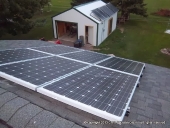




Rapping about Permaculture? You betcha! http://www.permies.com/t/50884/art/Music-Permaculture
 6
6




It's never too late to start! I retired to homestead on the slopes of Mauna Loa, an active volcano. I relate snippets of my endeavor on my blog : www.kaufarmer.blogspot.com
 2
2




M.R.J. Smith wrote:
Also read that solar panels are not sustainable at all because they require more energy to make in form of oil than they produce in their lifespan in the form of electricity.
My project thread
Agriculture collects solar energy two-dimensionally; but silviculture collects it three dimensionally.
 2
2




While south-facing solar panels are the most profitable for panel owners, they actually raise the demand for other power sources that they simultaneously put out of business. Relying on morning and evening sunlight means that solar panels aren’t producing as much as they could during the middle of the day, when communities need the bulk of their power. Therefore, homes with solar panels continue to rely on other power sources to support them during the middle of the day.
My project thread
Agriculture collects solar energy two-dimensionally; but silviculture collects it three dimensionally.
 3
3








Success has a Thousand Fathers , Failure is an Orphan
LOOK AT THE " SIMILAR THREADS " BELOW !




My project thread
Agriculture collects solar energy two-dimensionally; but silviculture collects it three dimensionally.




"If you want to save the environment, build a city worth living in." - Wendell Berry





Andrew Herzfeld
www.exergeia.com
 1
1




http://www.builditsolar.com/Projects/SolarHomes/Doug/DougsProjects.htm
http://www.youtube.com/user/sundug69




While south-facing solar panels are the most profitable for panel owners, they actually raise the demand for other power sources that they simultaneously put out of business.




Permaculture in Croatia:
www.perforum.info
 2
2




http://www.builditsolar.com/Projects/SolarHomes/Doug/DougsProjects.htm
http://www.youtube.com/user/sundug69
 1
1




Doug Kalmer wrote:I know personally 7 off grid households, they all have run thru several sets of expensive, toxic, heavy batteries, they all use dirty, noisy, PIA backup generators for the cloudy periods we get, they all only get 80-85% of the energy they put into batteries back from them, they all fill their battery banks when they have two sunny days in a row, then any more solar energy produced is wasted.
My project thread
Agriculture collects solar energy two-dimensionally; but silviculture collects it three dimensionally.




"If you want to save the environment, build a city worth living in." - Wendell Berry




 1
1




 2
2




Diverse seeds. Aromatic and medicinal herbs. And making stuff from it. Communicating with animals and plants. Stubbornly living by my own rules. Well, most of the time.
 5
5




Visit Redhawk's soil series: https://permies.com/wiki/redhawk-soil
How permies.com works: https://permies.com/wiki/34193/permies-works-links-threads
 2
2




John Daley Bendigo, Australia The Enemy of progress is the hope of a perfect plan
Benefits of rainfall collection https://permies.com/t/88043/benefits-rainfall-collection
GOOD DEBT/ BAD DEBT https://permies.com/t/179218/mortgages-good-debt-bad-debt
 3
3




M.R.J. Smith wrote:Interesting read- short sweet and to point!
http://www.popsci.com/article/science/americas-rooftop-solar-panels-are-probably-facing-wrong-direction?dom=PSC&loc=poprail&lnk=4&con=americas-rooftop-solar-panels-are-probably-facing-the-wrong-direction
Also read that solar panels are not sustainable at all because they require more energy to make in form of oil than they produce in their lifespan in the form of electricity.
What think you all?
 5
5




The best place to pray for a good crop is at the end of a hoe!
 1
1




Daniel
 1
1




Inmate, Natures Asylum, Siskiyou Ward
"Live Simply, So Others may SIMPLY LIVE"




Daniel Kaplan wrote:This article is pretty much spot on. Not sure you guys understood what they were getting at. I imagine the problems have only gotten worse as more and more people put solar panels on their roofs. Solar panels are normally aimed for maximum kWh production but without regard to when that electricity is needed. Those don't normally correspond. Max solar production is like 9 am to 3 pm. But max use is more like 3-7pm. The grid gets treated like a battery but it can't actually store any energy. Generally power companies run the most cost-efficient and cleanest burning power generation all the time and rely on peaker generation that can come online quickly. So what happens is solar produces around noon when use is moderate. This removes a lot of load from the grid, thus reducing the cost efficient and clean generation needed. Then in the late afternoon when everyone gets home from work and turns their ac on demand spikes. But, the clean electricity generations has been shut down and can't be brought back online quickly. I imagine some of those have been driven out of business permanently. The upshot is that production moves to generation that can come online quickly, mostly natural gas. I'm not sure exactly what their emissions are like relative to coal or nukes but at least in the past they weren't as clean because they weren't needed to run all the time.
Nowadays some places are investing in battery powered peaker plants. These could store some of the excess energy produced by solar panels but they're expensive and obviously there's a lot of dirty industry and mining that goes into producing or disposing of those.
Where I live, south is considered by solar designers to be the most advantageous direction to point panels followed by east and then west. West is at the bottom because of afternoon thunder storms. However, afternoon and evening is when that electricity is most needed. So pointing them west actually produces power when it's most needed and can be utilized. But so long as your power company hasn't gone to time-of-use metering it's true that you'll make the most money (at the expense of the electric company) by pointing your panels south. Lots of places are indeed moving to time of use metering to reflect the cost of generation and presumably give people incentive to use less during peak demand.
When I put up a few panels of my own I made sure I pointed a couple of them west.
DK
A build too cool to miss:Mike's GreenhouseA great example:Joseph's Garden
All the soil info you'll ever need:
Redhawk's excellent soil-building series





 1
1








Carl Nystrom wrote:I think what is being suggested is that there are 2 types of power plants, and that they generate differing levels of emissions per kWh. So imagine you had a base-load plant that was designed to always run, and could produce a kWh for lets say 100 units of emissions, and a "peaker" plant that could be brought online quickly but produced 200 units per kWh. If you produce a bunch of solar energy during the middle of the day, then the grid has to shut down the more efficient plants, because the grid is not really a battery, and the load needs to be matched to the demand. Once the sun goes down AND everyone comes home and turns up the heat/AC/microwaves their hotpocket dinners - then the demand is mismatched, and you have to fire up the less efficient plants (since the baseload plants would take hours to get back online, or whatever).
I have not researched the specifics, so I am not sure how big a problem this actually is anymore, but I believe the concept is correct. I do recall that a few years ago Germany actually saw an increase in their grid emissions due to these mis-matching effects as they tried to get their electricity to move more fully to renewables. They were getting like 50% from wind and sun, I want to say, but the intermittency issue caused them a lot of trouble. Not sure if it has been resolved now, or how their big "energiewende" program is working out for them. It is an interesting topic, and should really hammer home just what a massive undertaking it is going to be to wean ourselves off of the fossil fuel addiction that we are in the throes of.
I think using this as an excuse to say "look, solar just doesnt work" is going in the wrong direction (because just burning coal forever is not going to work out so well, either).
A build too cool to miss:Mike's GreenhouseA great example:Joseph's Garden
All the soil info you'll ever need:
Redhawk's excellent soil-building series





 1
1




I agree. The pair of issues: 1) time of production doesn't match time of consumption and 2) storing electricity is expensive and resource heavy, are *very* real! My Engineering son has explained these intersecting problems in great detail to me. People have focused very hard on the "production" side of the equation, because of pressure from everyone else about how "solar electric" can't fix our problem to the detriment of research needed in the very real "how do we store noon solar production until dinner time".Carl Nystrom wrote:I think using this as an excuse to say "look, solar just doesn't work" is going in the wrong direction (because just burning coal forever is not going to work out so well, either).
Visit Redhawk's soil series: https://permies.com/wiki/redhawk-soil
How permies.com works: https://permies.com/wiki/34193/permies-works-links-threads
 1
1




The holy trinity of wholesomeness: Fred Rogers - be kind to others; Steve Irwin - be kind to animals; Bob Ross - be kind to yourself
 2
2




Carl Nystrom wrote:I think what is being suggested is that there are 2 types of power plants, and that they generate differing levels of emissions per kWh. So imagine you had a base-load plant that was designed to always run, and could produce a kWh for lets say 100 units of emissions, and a "peaker" plant that could be brought online quickly but produced 200 units per kWh. If you produce a bunch of solar energy during the middle of the day, then the grid has to shut down the more efficient plants, because the grid is not really a battery, and the load needs to be matched to the demand. Once the sun goes down AND everyone comes home and turns up the heat/AC/microwaves their hotpocket dinners - then the demand is mismatched, and you have to fire up the less efficient plants (since the baseload plants would take hours to get back online, or whatever).
Daniel
 4
4
















 3
3




Robert Hogward wrote: Dust and other pollutants can reduce energy output from PV cells by more than 35%, so cleaning solar panels is obviously a must. If you find that the panels get dusty instantly, you might need to clean solar panels more often. Having a solar system installed requires you to perform regular cleaning and maintenance to ensure satisfying performance and extend their longevity.
Failure is a sign of activity and learning. It had nothing to do with under achievement
I never want to have a team member who has never failed - They are not doing!! 👍

|
I'm still in control here. LOOK at this tiny ad!
Learn Permaculture through a little hard work
https://wheaton-labs.com/bootcamp
|








